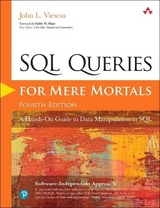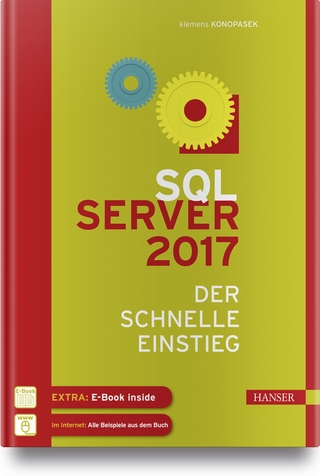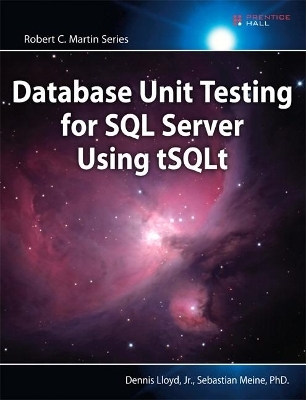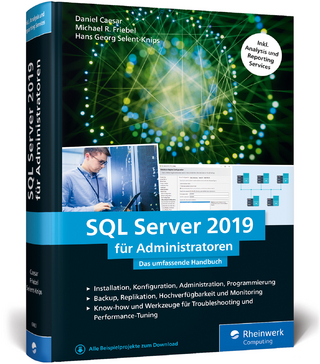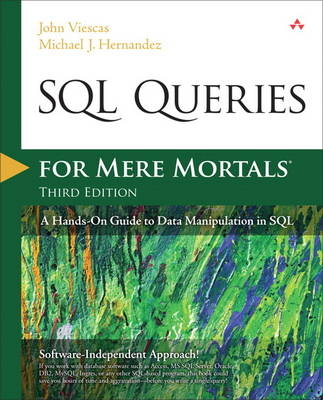
SQL Queries for Mere Mortals
Addison-Wesley Educational Publishers Inc (Verlag)
978-0-321-99247-5 (ISBN)
- Titel erscheint in neuer Auflage
- Artikel merken
SQL Queries for Mere Mortals® has earned worldwide praise as the clearest, simplest tutorial on writing effective SQL queries. The authors have updated this hands-on classic to reflect new SQL standards and database applications and teach valuable new techniques.
Step by step, John L. Viescas and Michael J. Hernandez guide you through creating reliable queries for virtually any modern SQL-based database. They demystify all aspects of SQL query writing, from simple data selection and filtering to joining multiple tables and modifying sets of data.
Three brand-new chapters teach you how to solve a wide range of challenging SQL problems. You’ll learn how to write queries that apply multiple complex conditions on one table, perform sophisticated logical evaluations, and think “outside the box” using unlinked tables.
Coverage includes
-- Getting started: understanding what relational databases are, and ensuring that your database structures are sound
-- SQL basics: using SELECT statements, creating expressions, sorting information with ORDER BY, and filtering data using WHERE
-- Summarizing and grouping data with GROUP BY and HAVING clauses
-- Drawing data from multiple tables: using INNER JOIN, OUTER JOIN, and UNION operators, and working with subqueries
-- Modifying data sets with UPDATE, INSERT, and DELETE statements Advanced queries: complex NOT and AND, conditions, if-then-else using CASE, unlinked tables, driver tables, and more
Practice all you want with downloadable sample databases for today’s versions of Microsoft Office Access, Microsoft SQL Server, and the open source MySQL database. Whether you’re a DBA, developer, user, or student, there’s no better way to master SQL.
informit.com/aw
forMereMortals.com
John L. Viescas is an independent database consultant with more than 45 years of experience. He began his career as a systems analyst, designing large database applications for IBM mainframe systems. He spent 6 years at Applied Data Research in Dallas, Texas, where he directed a staff of more than 30 people and was responsible for research, product development, and customer support of database products for IBM mainframe computers. While working at Applied Data Research, John completed a degree in business finance at the University of Texas at Dallas, graduating cum laude. John joined Tandem Computers, Inc., in 1988, where he was responsible for the development and implementation of database marketing programs in Tandem’s U.S. Western Sales region. He developed and delivered technical seminars on Tandem’s relational database management system, NonStop SQL. John wrote his first book, A Quick Reference Guide to SQL (Microsoft Press, 1989), as a research project to document the similarities in the syntax among the ANSI-86 SQL standard, IBM’s DB2, Microsoft’s SQL Server, Oracle Corporation’s Oracle, and Tandem’s NonStop SQL. He wrote the first edition of Running Microsoft Access (Microsoft Press, 1992) while on sabbatical from Tandem. He has since written four editions of Running, three editions of Microsoft Office Access Inside Out (Microsoft Press, 2003, 2007, and 2010–the successor to the Running series), and Building Microsoft Access Applications (Microsoft Press, 2005). John formed his own company in 1993. He provides information systems management consulting for a variety of small to large businesses around the world, with a specialty in the Microsoft Access and SQL Server database management products. He maintains offices in Nashua, New Hampshire, and Paris, France. He has been recognized as a “Most Valuable Professional” (MVP) since 1993 by Microsoft Product Support Services for his assistance with technical questions on public support forums. He set a landmark 20 consecutive years as an MVP in 2013. You can visit John’s Web site at www.viescas.com or contact him by e-mail at john@viescas.com. Michael J. Hernandez has been an independent relational database consultant specializing in relational database design. He has more than 20 years of experience in the technology industry, developing database applications for a wide variety of clients. He’s been a contributing author to a wide variety of magazine columns, white papers, books, and periodicals, and is coauthor of the best-selling SQL Queries for Mere Mortals. Mike has been a top-rated and noted technical trainer for the government,the military, the private sector, and companies throughout the United States. He has spoken at numerous national and international conferences, and has consistently been a top-rated speaker and presenter. Aside from his technical background,Mike has a diverse set of skills and interests that he also pursues, ranging from the artistic to the metaphysical. His greatest interest is still the guitar, as he’s been a practicing guitarist for more than 40 years and played professionally for 15 years. He’s also a working actor, a great cook, loves to teach (writing,public speaking,music), has a gift for bad puns, and even reads Tarot cards. He says he’s never going to retire, per se, but rather just change whatever it is he’s doing whenever he finally gets tired of it and move on to something else that interests him.
Foreword xvii
Preface xix
About the Authors xxi
Introduction xxiii
Are You a Mere Mortal? xxiii
About This Book xxiv
What This Book Is Not xxvi
How to Use This Book xxvi
Reading the Diagrams Used in This Book xxvii
Sample Databases Used in This Book xxxi
“Follow the Yellow Brick Road” xxxiii
Part I Relational Databases and SQL 1
Chapter 1 What Is Relational? 3
Types of Databases 3
A Brief History of the Relational Model 4
In the Beginning . . . 4
Relational Database Systems 5
Anatomy of a Relational Database 7
Tables 7
Fields 9
Records 9
Keys 9
Views 11
Relationships 12
What’s in It for You? 17
Where Do You Go from Here? 18
Summary 19
Chapter 2 Ensuring Your Database Structure Is Sound 21
Why Is This Chapter Here? 21
Why Worry about Sound Structures? 22
Fine-Tuning Fields 23
What’s in a Name? (Part One) 23
Smoothing Out the Rough Edges 25
Resolving Multipart Fields 27
Resolving Multivalued Fields 30
Fine-Tuning Tables 32
What’s in a Name? (Part Two) 33
Ensuring a Sound Structure 35
Resolving Unnecessary Duplicate Fields 36
Identification Is the Key 42
Establishing Solid Relationships 45
Establishing a Deletion Rule 48
Setting the Type of Participation 49
Setting the Degree of Participation 52
Is That All? 54
Summary 55
Chapter 3 A Concise History of SQL 57
The Origins of SQL 58
Early Vendor Implementations 59
“. . . And Then There Was a Standard” 60
Evolution of the ANSI/ISO Standard 62
Other SQL Standards 65
Commercial Implementations 68
What the Future Holds 69
Why Should You Learn SQL? 69
Which Version of SQL Does This Book Cover? 70
Summary 70
Part II SQL Basics 73
Chapter 4 Creating a Simple Query 75
Introducing SELECT 76
The SELECT Statement 77
A Quick Aside: Data versus Information 79
Translating Your Request into SQL 81
Expanding the Field of Vision 85
Using a Shortcut to Request All Columns 87
Eliminating Duplicate Rows 88
Sorting Information 91
First Things First: Collating Sequences 92
Let’s Now Come to Order 93
Saving Your Work 96
Sample Statements 97
Summary 106
Problems for You to Solve 107
Chapter 5 Getting More Than Simple Columns 109
What Is an Expression? 110
What Type of Data Are You Trying to Express? 111
Changing Data Types: The CAST Function 114
Specifying Explicit Values 116
Character String Literals 116
Numeric Literals 118
Datetime Literals 119
Types of Expressions 121
Concatenation 122
Mathematical Expressions 125
Date and Time Arithmetic 129
Using Expressions in a SELECT Clause 133
Working with a Concatenation Expression 134
Naming the Expression 135
Working with a Mathematical Expression 137
Working with a Date Expression 138
A Brief Digression: Value Expressions 139
That “Nothing” Value: Null 141
Introducing Null 142
The Problem with Nulls 143
Sample Statements 144
Summary 153
Problems for You to Solve 154
Chapter 6 Filtering Your Data 157
Refining What You See Using WHERE 157
The WHERE Clause 158
Using a WHERE Clause 160
Defining Search Conditions 162
Comparison 163
Range 170
Set Membership 173
Pattern Match 175
Null 179
Excluding Rows with NOT 181
Using Multiple Conditions 184
Introducing AND and OR 185
Excluding Rows: Take Two 191
Order of Precedence 193
Checking for Overlapping Ranges 197
Nulls Revisited: A Cautionary Note 199
Expressing Conditions in Different Ways 203
Sample Statements 204
Summary 212
Problems for You to Solve 213
Part III Working with Multiple Tables 217
Chapter 7 Thinking in Sets 219
What Is a Set, Anyway? 220
Operations on Sets 221
Intersection 222
Intersection in Set Theory 222
Intersection between Result Sets 224
Problems You Can Solve with an Intersection 227
Difference 228
Difference in Set Theory 228
Difference between Result Sets 230
Problems You Can Solve with Difference 233
Union 234
Union in Set Theory 234
Combining Result Sets Using a Union 236
Problems You Can Solve with Union 238
SQL Set Operations 239
Classic Set Operations versus SQL 239
Finding Common Values: INTERSECT 240
Finding Missing Values: EXCEPT (DIFFERENCE) 243
Combining Sets: UNION 245
Summary 248
Chapter 8 INNER JOINs 249
What Is a JOIN? 249
The INNER JOIN 250
What’s “Legal” to JOIN? 250
Column References 251
Syntax 252
Check Those Relationships! 267
Uses for INNER JOINs 268
Find Related Rows 268
Find Matching Values 269
Sample Statements 269
Two Tables 270
More Than Two Tables 276
Looking for Matching Values 283
Summary 294
Problems for You to Solve 295
Chapter 9 OUTER JOINs 299
What Is an OUTER JOIN? 299
The LEFT/RIGHT OUTER JOIN 301
Syntax 302
The FULL OUTER JOIN 320
Syntax 320
FULL OUTER JOIN on Non-Key Values 323
UNION JOIN 323
Uses for OUTER JOINs 324
Find Missing Values 324
Find Partially Matched Information 325
Sample Statements 325
Summary 341
Problems for You to Solve 341
Chapter 10 UNIONs 345
What Is a UNION? 345
Writing Requests with UNION 348
Using Simple SELECT Statements 348
Combining Complex SELECT Statements 351
Using UNION More Than Once 355
Sorting a UNION 357
Uses for UNION 358
Sample Statements 359
Summary 371
Problems for You to Solve 372
Chapter 11 Subqueries 375
What Is a Subquery? 376
Row Subqueries 376
Table Subqueries 377
Scalar Subqueries 378
Subqueries as Column Expressions 378
Syntax 378
An Introduction to Aggregate Functions: COUNT and MAX 381
Subqueries as Filters 384
Syntax 384
Special Predicate Keywords for Subqueries 386
Uses for Subqueries 397
Build Subqueries as Column Expressions 397
Use Subqueries as Filters 398
Sample Statements 399
Subqueries in Expressions 399
Subqueries in Filters 405
Summary 413
Problems for You to Solve 414
Part IV Summarizing and Grouping Data 417
Chapter 12 Simple Totals 419
Aggregate Functions 420
Counting Rows and Values with COUNT 422
Computing a Total with SUM 425
Calculating a Mean Value with AVG 427
Finding the Largest Value with MAX 428
Finding the Smallest Value with MIN 430
Using More Than One Function 431
Using Aggregate Functions in Filters 432
Sample Statements 435
Summary 442
Problems for You to Solve 443
Chapter 13 Grouping Data 445
Why Group Data? 446
The GROUP BY Clause 448
Syntax 449
Mixing Columns and Expressions 454
Using GROUP BY in a Subquery in a WHERE Clause 456
Simulating a SELECT DISTINCT Statement 457
“Some Restrictions Apply” 458
Column Restrictions 459
Grouping on Expressions 461
Uses for GROUP BY 462
Sample Statements 463
Summary 474
Problems for You to Solve 475
Chapter 14 Filtering Grouped Data 477
A New Meaning of “Focus Groups” 478
Where You Filter Makes a Difference 482
Should You Filter in WHERE or in HAVING? 482
Avoiding the HAVING COUNT Trap 485
Uses for HAVING 490
Sample Statements 491
Summary 499
Problems for You to Solve 500
Part V Modifying Sets of Data 503
Chapter 15 Updating Sets of Data 505
What Is an UPDATE? 505
The UPDATE Statement 506
Using a Simple UPDATE Expression 507
A Brief Aside: Transactions 510
Updating Multiple Columns 511
Using a Subquery to Filter Rows 512
Using a Subquery UPDATE Expression 518
Uses for UPDATE 520
Sample Statements 521
Summary 538
Problems for You to Solve 538
Chapter 16 Inserting Sets of Data 541
What Is an INSERT? 541
The INSERT Statement 543
Inserting Values 543
Generating the Next Primary Key Value 547
Inserting Data by Using SELECT 548
Uses for INSERT 555
Sample Statements 556
Summary 568
Problems for You to Solve 568
Chapter 17 Deleting Sets of Data 571
What Is a DELETE? 571
The DELETE Statement 572
Deleting All Rows 573
Deleting Some Rows 575
Uses for DELETE 579
Sample Statements 580
Summary 588
Problems for You to Solve 589
Part VI Introduction to Solving Tough Problems 591
Chapter 18 “NOT” and “AND” Problems 593
A Short Review of Sets 593
Sets with Multiple AND Criteria 594
Sets with Multiple NOT Criteria 595
Sets Including Some Criteria but Excluding Others 596
Finding Out the “Not” Case 597
Using OUTER JOIN 598
Using NOT IN 601
Using NOT EXISTS 603
Using GROUP BY/HAVING 604
Finding Multiple Matches in the Same Table 607
Using INNER JOIN 608
Using IN 610
Using EXISTS 612
Using GROUP BY/HAVING 614
Sample Statements 618
Summary 636
Problems for You to Solve 637
Chapter 19 Condition Testing 641
Conditional Expressions (CASE) 641
Why Use CASE? 642
Syntax 642
Solving Problems with CASE 647
Solving Problems with Simple CASE 647
Solving Problems with Searched CASE 652
Using CASE in a WHERE Clause 655
Sample Statements 655
Summary 669
Problems for You to Solve 669
Chapter 20 Using Unlinked Data and “Driver” Tables 671
What Is Unlinked Data? 672
Deciding When to Use a CROSS JOIN 675
Solving Problems with Unlinked Data 676
Solving Problems Using “Driver” Tables 679
Setting Up a Driver Table 679
Using a Driver Table 682
Sample Statements 686
Examples Using Unlinked Tables 687
Examples Using Driver Tables 697
Summary 705
Problems for You to Solve 705
In Closing 709
Appendices 711
Appendix A SQL Standard Diagrams 713
Appendix B Schema for the Sample Databases 723
Sales Orders Example Database 724
Sales Orders Modify Database 725
Entertainment Agency Example Database 726
Entertainment Agency Modify Database 727
School Scheduling Example Database 728
School Scheduling Modify Database 729
Bowling League Example Database 730
Bowling League Modify Database 731
Recipes Database 732
Appendix C Date and Time Types, Operations, and Functions 733
IBM DB2 733
Microsoft Office Access 736
Microsoft SQL Server 738
MySQL 740
Oracle 743
Appendix D Suggested Reading 745
Database Books 745
Books on SQL 745
9780321992475 TOC 5/20/2014
| Erscheint lt. Verlag | 26.6.2014 |
|---|---|
| Verlagsort | New Jersey |
| Sprache | englisch |
| Maße | 179 x 231 mm |
| Gewicht | 1200 g |
| Themenwelt | Informatik ► Datenbanken ► SQL Server |
| Mathematik / Informatik ► Informatik ► Software Entwicklung | |
| ISBN-10 | 0-321-99247-4 / 0321992474 |
| ISBN-13 | 978-0-321-99247-5 / 9780321992475 |
| Zustand | Neuware |
| Informationen gemäß Produktsicherheitsverordnung (GPSR) | |
| Haben Sie eine Frage zum Produkt? |
aus dem Bereich
